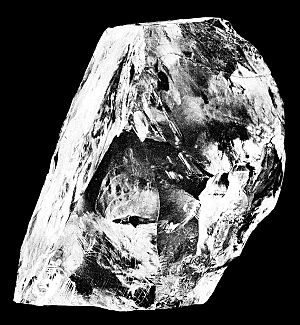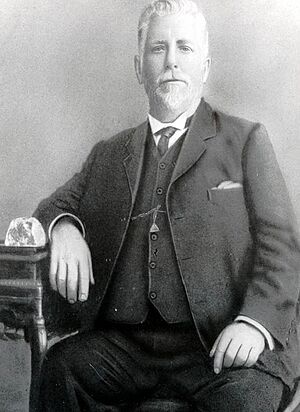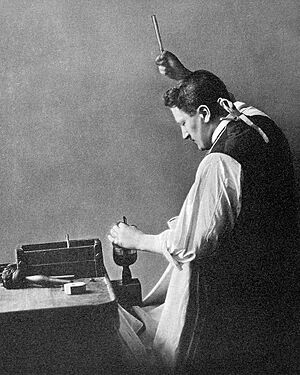Cullinan Diamond facts for kids

The rough diamond
|
|
| Weight | 3,106 carats (621.2 g) |
|---|---|
| Colour | Near colourless |
| Cut | 105 stones of assorted cuts |
| Country of origin | South Africa |
| Mine of origin | Premier Mine |
| Cut by | Joseph Asscher & Co. |
| Original owner | Premier Diamond Mining Company |
| Owner | Charles III in right of The Crown |
The Cullinan Diamond is the biggest and most amazing gem-quality diamond ever found! It weighed a massive 3,106 carats (621.20 g) when it was discovered. This incredible stone was found in South Africa on January 26, 1905, at the Premier No.2 mine in a town called Cullinan. It was named after Thomas Cullinan, who owned the mine.
After its discovery, the Cullinan Diamond was put up for sale in London. Even though many people were interested, it took two years to find a buyer. In 1907, the government of the Transvaal Colony (a region in South Africa at the time) bought the diamond. Their leader, Prime Minister Louis Botha, then gave it as a special gift to King Edward VII of the United Kingdom.
Later, a famous company called Joseph Asscher & Co. in Amsterdam carefully cut the huge diamond. From it came many beautiful stones of different shapes and sizes. The biggest one is called Cullinan I, also known as the Great Star of Africa. It weighs 530.4 carats (106.08 g) and is the largest clear cut diamond in the world! You can see it in the Sovereign's Sceptre with Cross. The second largest is Cullinan II, or the Second Star of Africa, weighing 317.4 carats (63.48 g). This diamond is set in the Imperial State Crown. Both of these amazing diamonds are part of the Crown Jewels of the United Kingdom. Other smaller Cullinan diamonds were passed down through the royal family, with Elizabeth II inheriting several from her grandmother, Queen Mary.
Contents
Discovering the Giant Diamond
A Special Find in South Africa
Imagine finding a diamond that formed deep inside the Earth, hundreds of kilometers down! The Cullinan Diamond did just that, reaching the surface over a billion years ago. On January 26, 1905, a mine manager named Frederick Wells found it. He was working at the Premier Mine in Cullinan, South Africa. The diamond was about 5.5 metres (18 ft) below the ground.
This rough diamond was huge! It measured about 10.1 centimetres (4.0 in) long, 6.35 centimetres (2.50 in) wide, and 5.9 centimetres (2.3 in) deep. It weighed an incredible 3,106 carats (621.2 grams). People quickly started calling it the "Cullinan Diamond" after Sir Thomas Cullinan, who owned the mine. It was three times bigger than the Excelsior Diamond, which was the largest found before it. The Cullinan Diamond had a beautiful blue-white color. It even had a tiny air pocket inside that sometimes made a rainbow effect!
A Tricky Journey to London
After its discovery, the Cullinan Diamond was put on display in Johannesburg. Thousands of people came to see this amazing gem. In April 1905, it was time to send the diamond to London for sale. Because it was so valuable, everyone worried about thieves.
To trick any potential robbers, a clever plan was made. A ship called the RMS Kenilworth Castle was rumored to be carrying the diamond. A special package was locked in the captain's safe and guarded closely. But guess what? The diamond on that ship was a fake! The real Cullinan Diamond was sent to the United Kingdom in a simple box by registered mail. Once it arrived in London, King Edward VII himself inspected it at Buckingham Palace. Even with all the excitement, the diamond remained unsold for two years.
A Royal Gift
From South Africa to King Edward VII
In 1907, the Prime Minister of the Transvaal Colony, Louis Botha, had a great idea. He suggested that the government buy the Cullinan Diamond. He wanted to give it to King Edward VII as a special gift. This gift would show how loyal the people of the Transvaal were to the King.
After some discussion, the government agreed to buy the diamond. It cost £150,000, which was a huge amount of money back then! Even the British Prime Minister at first thought the King should say no. But Winston Churchill, who was a government official at the time, helped convince the King to accept. Churchill even received a replica of the diamond, which he loved to show off!
The Cullinan Diamond was officially given to King Edward VII on November 9, 1907. This was a special day because it was his 66th birthday! The King accepted the diamond, promising that this "great and unique diamond" would be kept safe. It would become part of the historic jewels belonging to the Crown, meaning it would be passed down to future kings and queens.
Cutting the Cullinan
The Master Cutter's Challenge
King Edward VII chose the famous Joseph Asscher & Co. in Amsterdam to cut and polish the giant Cullinan Diamond. On January 23, 1908, Abraham Asscher picked up the diamond in London. He traveled back to the Netherlands by train and ferry, carrying the priceless gem safely in his coat pocket. Just like before, a trick was played on potential thieves! A Royal Navy ship sailed across the North Sea with an empty box, pretending to carry the diamond.
Cutting such a huge and valuable diamond was incredibly difficult and risky. Joseph Asscher spent weeks planning how to do it. On February 10, 1908, he made a tiny cut, only 0.5 inches (13 mm) deep, to prepare the diamond for splitting. This small cut alone took four days! His first steel knife broke, but a second one worked, splitting the diamond perfectly in two.
The whole process of splitting and cutting the Cullinan Diamond took eight months. Three people worked 14 hours a day to finish the job! There's a famous story that Joseph Asscher fainted from stress after he made the first successful split. But his nephew, Louis Asscher, later said, "No Asscher would ever faint over any operation on any diamond!" He thought Joseph would have celebrated instead.
The Famous Cullinan Diamonds
The original Cullinan Diamond was cut into 9 major stones, weighing a total of 1,055.89 carats (211.178 g). It also produced 96 smaller brilliants and some tiny unpolished pieces. The two largest stones, Cullinan I and II, became part of the British Crown Jewels. The other stones were given to Queen Mary in 1910. She later passed them down to her granddaughter, Elizabeth II.
Cullinan I: The Great Star of Africa
Cullinan I is also known as the Great Star of Africa. It is a pear-shaped diamond with 74 facets, weighing 530.2 carats (106.04 g). This makes it the largest colorless cut diamond in the world! It is set at the very top of the Sovereign's Sceptre with Cross. The scepter had to be redesigned in 1910 just to hold this magnificent stone. Cullinan I can even be removed from the scepter and worn as a pendant with Cullinan II, forming a beautiful brooch.
Cullinan II: The Second Star of Africa
Cullinan II, or the Second Star of Africa, is a cushion-cut diamond. It has 66 facets and weighs 317.4 carats (63.48 g). This stunning diamond is set in the front of the Imperial State Crown. It sits just below the famous Black Prince's Ruby. Like Cullinan I, it is held securely in place by a gold setting that is screwed onto the crown.
Cullinan III and IV: "Granny's Chips"
Cullinan III is a pear-shaped diamond weighing 94.4 carats (18.88 g). Cullinan IV is a square-cut diamond weighing 63.6 carats (12.72 g). These two diamonds have a special nickname in the royal family: "Granny's Chips"! Elizabeth II often wore them together as a brooch.
In 1911, Cullinan IV was first set in the base of Queen Mary's Crown. Cullinan III was set in the top cross of a crown Queen Mary bought for her coronation. In 2023, both diamonds were re-set in Queen Mary's Crown for use by Queen Camilla. On a visit to the Netherlands in 1958, Queen Elizabeth II showed the brooch to Louis Asscher, whose uncle had cut the original diamond. He was very touched to see them again after so many years.
Other Beautiful Cullinan Stones
The remaining Cullinan diamonds are also very special:
- Cullinan V is a heart-shaped diamond weighing 18.8 carats (3.76 g). It is set in a platinum brooch. This brooch was worn by Queen Mary at the Delhi Durbar in 1911. In May 2023, it was placed on the front of Queen Mary's Crown for Queen Camilla's Coronation.
- Cullinan VI is a marquise-cut diamond weighing 11.5 carats (2.30 g). It often hangs from a brooch that also holds Cullinan VIII.
- Cullinan VII is also marquise-cut and weighs 8.8 carats (1.76 g). It was given by King Edward VII to his wife, Queen Alexandra. She later gave it to Queen Mary, who had it set as a pendant on a diamond-and-emerald necklace.
- Cullinan VIII is an oblong-cut diamond weighing 6.8 carats (1.36 g). It is set in the center of a brooch.
- Cullinan IX is the smallest of the main Cullinan diamonds. It is a pear-shaped stone weighing 4.39 carats (0.878 g). It is set in a platinum ring known as the Cullinan IX Ring.
See also
 In Spanish: Cullinan para niños
In Spanish: Cullinan para niños
- List of diamonds
- List of largest rough diamonds
- Elizabeth II's jewels





